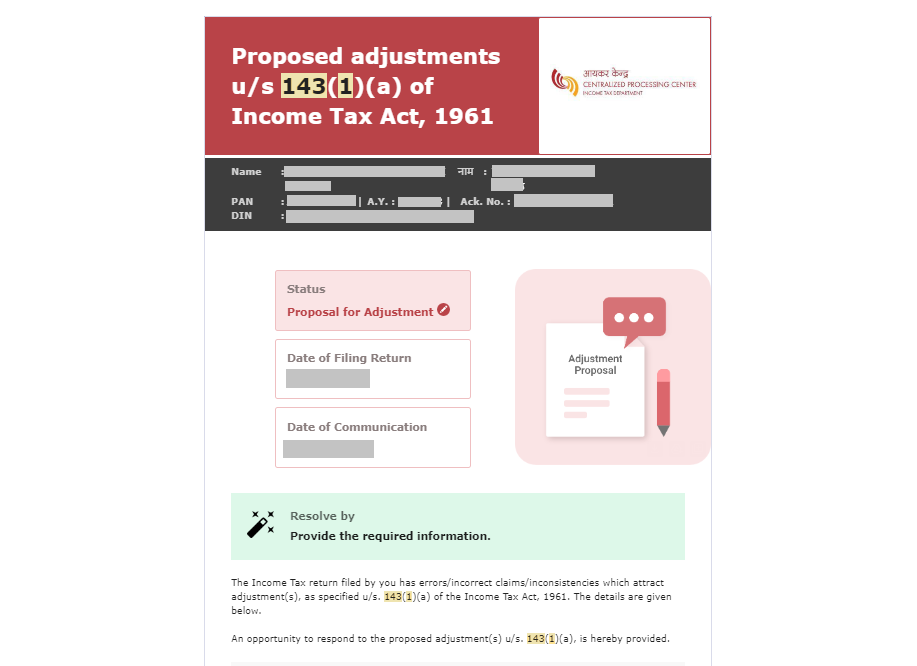Table of Contents
- Reason to receive Intimations under Section 143 (1)
- What is Intimation u/s 143(1) of the Income Tax Act
- What are the details included in Intimation u/s 143(1)
- Through which channels taxpayers receive this notice
- What is the Password to Open Intimation u/s 143(1)
- How to respond to a notice under Section 143(1)
- Time Limit to respond
- Understanding Notice under Section 143(1)(a) and its different reasons

Reason to receive Intimations under Section 143 (1)
Intimations under Section 143(1) of the Income Tax Act can be received if:
- Found any discrepancies between the TDS details reported by the taxpayer and the data available with the Income Tax Department.
- Inaccurate in claiming deductions or exemptions under various sections of the Income Tax Act.
- Incorrect or mismatched Permanent Account Number (PAN) or Aadhaar details provided in the return.
- Mistakes while filling return may also lead to discrepancies in the computed tax liability.
What is Intimation u/s 143(1) of the Income Tax Act
Intimation under Section 143(1) is a notification which is sent from the IT Department after processing a taxpayer's income tax return. Usually, it informs the taxpayer about any discrepancies between their filed return and the department's computation. It provides a preliminary computation of the taxpayer's tax liability and indicates whether the returns filed are matched with the tax computation conducted by the department.
What are the details included in Intimation u/s 143(1)
- Sequence number of refund If applicable
- Assesses details about the taxpayer, including name, address, etc.
- The tax liability is calculated by the Income Tax Department under Section 143(1).
- Other filing details such as the filing date, acknowledgement number, etc., related to the income tax return.
- A comparison between the tax calculation provided in the taxpayer's return and the computation done by the Tax Department.
Through which channels taxpayers receive this notice
- Department may sends the intimation to the taxpayer's registered email address.
- Through the taxpayer's registered account on the income tax e-filing portal. To view the Intimation u/s 143(1) :
- Log in to the income tax e-filing portal.
- Go to "My Account".
- Click on "View e-Filed Returns/Forms."
- Select the appropriate assessment year.
- Click on the acknowledgement number of the tax return for which intimation is required.
- Download the intimation in PDF format.
- Taxpayers may receive an SMS on their registered mobile number informing them that the intimation has been sent.
What is the Password to Open Intimation u/s 143(1)
Intimations u/s143(1) received are usually password-protected for security reasons. The password consists of the taxpayer's PAN in lowercase letters followed by the date of birth or incorporation in the DDMMYYYY format.
For example, if the PAN is "EFGPA1234F" and the date of birth is 15th Oct 1993, the password would be "efgpa1234f15101993."
How to respond to a notice under Section 143(1)
If there are no adjustments, there is no need to respond to an intimation under Section 143(1). However, if a taxpayer disagrees with the adjustments made or needs to provide additional information, they should respond within the specified time frame.

The following steps are required to respond to a notice under Section 143(1):
- Firstly, verify personal details, review all eligible deductions and exemptions claimed in your return and income details whether it have been accurately considered.
- Provide appropriate explanations, supporting documents, or corrections.
- Send your response within the specified time, either online through the income tax e-filing portal or by visiting a designated office.
Time Limit to respond
The time limit is within nine months from the end of the financial year in which the return is filed.
For example, if a taxpayer files a return for the financial year 2022-23 in July 2023, the intimation can be sent within 31 December 2024.
If no intimation is received within this period, it means there are no adjustments to the filed return, and the acknowledgement filed is deemed to be the Section 143(1) intimation.
Understanding Notice under Section 143(1)(a) and its different reasons
Notice under Section 143(1)(a) is notification which is send by the Income Tax Department to taxpayer to make necessary adjustments or changes in their filed IT return.
Notice under Section 143(1)(a) may be send due to different reasons :
| Section 143(1)(a)(i) | This notice is issued by the department if they found a math error in your tax return. It points out where the numbers don't add up according to their calculations. |
| Section 143(1)(a)(ii) | This notice is issued for an incorrect claim, missing information, or claiming deductions beyond what's allowed in your return. |
| Section 143(1)(a)(iii) | This notice is sent if return is filed after the deadline and claimed losses. The tax department won't allow the loss claim if you file late. |
| Section 143(1)(a)(iv) | This notice is issued by the IT department if you claim an expense in your return that an audit report says you can't. They will reject the same, if you still claim it. |
| Section 143(1)(a)(v) | If you claim certain deductions but file after the deadline, expect this notice. You can't claim these deductions if you file late. |
| Section 143(1)(a)(vi) | This notice shows a discrepancy in your salary details or TDS. It may be mismatches between your business income, salary declared in Form 16, or taxable salary in your return. |







 CAclubindia
CAclubindia
